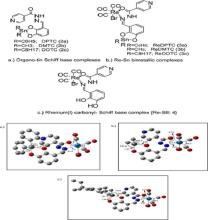Synthesis, structural elucidation, and catalytic activity of bimetallic rhenium-tin complexes containing Schiff base ligand
| Abstract | Novel bimetallic systems with Re and Sn metals, containing Schiff base linker were designed and explored for their cooperative effect in the catalysis. ReSn bimetallic complexes were prepared by adopting a two-step synthesis procedure, which includes covalent binding of Sn with the Schiff base and then with the Re(CO)5Br. The Schiff base, (E)- N’-(2, 3-dihydroxybenzylidene)isonicotinohydrazide (H2L,1) was used in the preparation of three Schiff base diorganotin (IV) complexes; Diphenyltin(IV) Schiff base complex (DPTC, (2a)), Dimethyltin(IV) Schiff base complex (DMTC, (2b)); and Dioctyltin(IV) Schiff base complex (DOTC, (2c)). The Schiff base organotin (IV) complexes, 2a-2c were used as precursors to synthesize bimetallic ReSn complexes. The ReSn bimetallic complexes; ReDPTC (3a), ReDMTC (3b) and ReDOTC (3c) were prepared by treating respective organotin(IV) Schiff base complex, DPTC (2a), DMTC (2b), DOTC (2c) with the rhenium pentacarbonyl bromide (Re(CO)5Br). All the three ReSn bimetallic complexes 3a, 3b and 3c were characterized by FTIR, HRMS, EDX, and UV-Vis spectroscopy. DFT studies were employed to rationalize the ground state structure of the synthesized bimetallic complexes. The catalytic activity of compounds 3a, 3b, 3c were investigated for selective oxidation of anthracene to 9,10 anthraquinone under mild reaction conditions by employing H2O2 as an oxidizing agent. The catalyst 3a (ReDPTC) with the phenyl substituent on the Sn has shown excellent catalytic activity (96.9 % conversion with 100% selectivity) in comparison to 3b (with methyl substituent) and 3c (with octyl substituent). |
| Faculty |
Harminder Kaur
|
|
hkaur@pec.edu.in
|
|
| More Information | DOI: https://doi.org/10.1016/j.molstruc.2021.131545 |







